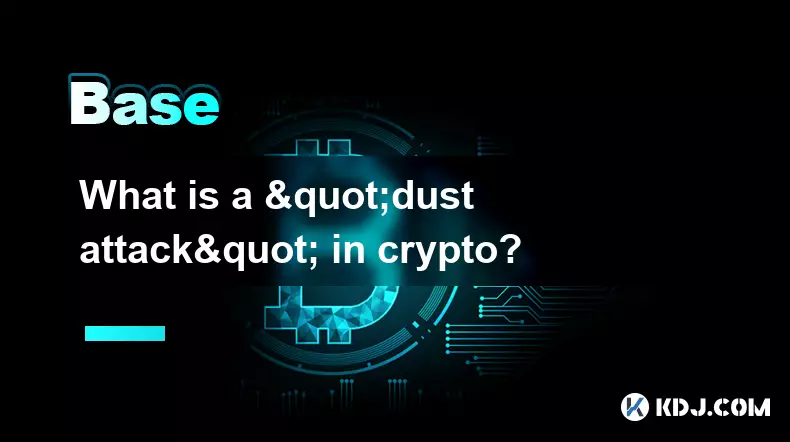-
 bitcoin
bitcoin $108842.957301 USD
-1.88% -
 ethereum
ethereum $3931.777121 USD
-1.66% -
 tether
tether $1.000186 USD
-0.03% -
 bnb
bnb $1153.250882 USD
-2.20% -
 xrp
xrp $2.367904 USD
-1.94% -
 solana
solana $186.182050 USD
-4.20% -
 usd-coin
usd-coin $0.999997 USD
0.00% -
 tron
tron $0.316949 USD
-1.00% -
 dogecoin
dogecoin $0.190780 USD
-3.12% -
 cardano
cardano $0.651324 USD
-2.67% -
 hyperliquid
hyperliquid $37.141055 USD
-0.85% -
 ethena-usde
ethena-usde $0.999224 USD
-0.09% -
 chainlink
chainlink $17.579031 USD
-2.47% -
 bitcoin-cash
bitcoin-cash $509.426284 USD
-2.79% -
 stellar
stellar $0.315298 USD
-2.93%
What is a "dust attack" in crypto?
Dust attacks flood wallets with tiny crypto amounts to track user activity and de-anonymize transactions by linking addresses through blockchain analysis.
Oct 12, 2025 at 06:36 pm

Understanding Dust Attacks in the Cryptocurrency Ecosystem
1. A dust attack involves sending minuscule amounts of cryptocurrency, often fractions of a cent, to thousands or even millions of wallet addresses. These tiny sums are referred to as 'dust' because they are so small that they are practically worthless and uneconomical to spend due to transaction fees.
2. The primary intent behind such attacks is not financial gain but rather privacy invasion. Attackers distribute this dust across numerous wallets with the goal of tracking how users interact with their funds. By monitoring when and where the dust is moved, malicious actors can potentially link multiple addresses to a single entity.
3. Blockchain transactions are public and immutable, meaning every movement of funds can be traced using analytical tools. When a user consolidates their funds or spends from an address containing dust, the transaction may include both legitimate balances and the dust amount, thereby revealing connections between previously unrelated addresses.
4. Some attackers use sophisticated clustering algorithms to analyze transaction patterns. Once dust has been received, if it's spent alongside other funds, it serves as a marker. This compromises the pseudonymous nature of blockchain networks, especially for users who believe their identities are hidden behind multiple wallet addresses.
5. Wallet providers and security experts have raised awareness about this threat. Certain wallets now offer features to flag or isolate incoming dust, preventing accidental spending that could expose ownership links. Users are advised never to engage with suspiciously small inbound transactions unless they fully understand the implications.
Common Targets and Methods of Distribution
1. High-profile individuals, exchange wallets, and active traders are common targets due to the volume and frequency of their transactions, which provide rich data for analysis.
2. Attackers often use automated scripts to distribute dust across large swathes of known addresses pulled from blockchain explorers or leaked databases.
3. In some cases, phishing techniques are combined with dust attacks—users receive messages urging them to interact with the dust, such as claiming fake rewards, which leads them to visit malicious websites or reveal private keys.
4. Bitcoin, being the most transparent and widely analyzed blockchain, sees a higher incidence of dust attacks, though similar tactics have emerged on Ethereum and other public ledgers.
5. Forked coins or airdrops based on existing chain data can also result in unintentional dust distribution, blurring the line between genuine airdrops and coordinated tracking attempts.
Protecting Your Crypto Privacy Against Dust
1. Avoid spending or moving any transaction outputs labeled as dust without understanding the risks involved. Never consolidate dust with your main holdings in a single transaction.
2. Use wallets that support coin control, allowing you to manually select which UTXOs (unspent transaction outputs) are used during transfers, so you can exclude tainted ones.
3. Consider running a full node or using privacy-focused tools like CoinJoin, which mix your transactions with others to obscure the trail of funds.
4. Enable address labeling and watchlists in your wallet software to detect and quarantine unknown inputs automatically.
5. Stay informed about known dust campaigns by following updates from blockchain analysts and cybersecurity researchers specializing in crypto threats.
Frequently Asked Questions
What should I do if I receive a suspiciously small amount of crypto?Ignore it. Do not spend or move the funds. Most modern wallets will mark these transactions as low-value or potentially harmful. Leaving the dust untouched prevents linkage to other addresses you control.
Can dust attacks steal my cryptocurrency?No, receiving dust does not give attackers access to your private keys or funds. However, by analyzing how you use your wallet, they might uncover personal information or behavioral patterns that compromise your anonymity.
Are hardware wallets immune to dust attacks?Hardware wallets protect your private keys but cannot prevent dust from being sent to your addresses. The vulnerability lies in transaction behavior, not device security. Even with a hardware wallet, improper handling of dust can expose your financial graph.
Is all unsolicited crypto considered a dust attack?Not necessarily. Some small transfers are part of legitimate airdrops or promotional campaigns. However, any uninvited transaction—especially one with negligible value—should be treated with caution until verified through official channels.
Disclaimer:info@kdj.com
The information provided is not trading advice. kdj.com does not assume any responsibility for any investments made based on the information provided in this article. Cryptocurrencies are highly volatile and it is highly recommended that you invest with caution after thorough research!
If you believe that the content used on this website infringes your copyright, please contact us immediately (info@kdj.com) and we will delete it promptly.
- Navigating Crypto Chaos: Is Bitcoin, Ethereum, or Solana a Safe Haven?
- 2025-10-18 02:25:13
- Altcoin Season on Hold? Index Tumbles Amidst Data Analysis
- 2025-10-18 02:45:12
- Boston Music Awards 2025: Nominees Announced!
- 2025-10-18 02:45:12
- Morpho's DeFi Dance: Liquidity Slides, Ethereum Foundation's Moves, and What It All Means
- 2025-10-18 02:50:13
- OpenSea's Multi-Chain Evolution: From NFTs to Crypto Aggregator
- 2025-10-18 02:25:13
- SEA Token, OpenSea, and Trading Volume: What's the Deal?
- 2025-10-18 02:26:10
Related knowledge

How do decentralized identity (DID) solutions work?
Oct 14,2025 at 11:36pm
Understanding Decentralized Identity in the Blockchain Ecosystem1. Decentralized identity (DID) solutions are built on blockchain networks, allowing i...

What is the difference between Near Protocol and Ethereum?
Oct 15,2025 at 08:01am
Near Protocol and Ethereum: Core Architectural Differences1. Near Protocol operates on a sharded blockchain architecture known as Nightshade, which al...

What does it mean for code to be "open source" in crypto?
Oct 12,2025 at 01:54pm
Understanding Open Source in the Cryptocurrency Ecosystem1. In the context of cryptocurrency, open source refers to software whose code is publicly ac...

What is the purpose of a "testnet"?
Oct 12,2025 at 09:01am
Understanding the Role of Testnets in Blockchain Development1. A testnet serves as a parallel version of a blockchain network, designed specifically f...

How to avoid phishing scams in crypto?
Oct 13,2025 at 06:18pm
Understanding Common Crypto Phishing Tactics1. Cybercriminals frequently use fake websites that mirror legitimate crypto exchanges or wallet platforms...

What is the difference between single-collateral and multi-collateral Dai?
Oct 12,2025 at 05:18pm
Understanding Single-Collateral Dai1. Single-Collateral Dai (SCD) was the original version of the Dai stablecoin launched by MakerDAO in 2017. It allo...

How do decentralized identity (DID) solutions work?
Oct 14,2025 at 11:36pm
Understanding Decentralized Identity in the Blockchain Ecosystem1. Decentralized identity (DID) solutions are built on blockchain networks, allowing i...

What is the difference between Near Protocol and Ethereum?
Oct 15,2025 at 08:01am
Near Protocol and Ethereum: Core Architectural Differences1. Near Protocol operates on a sharded blockchain architecture known as Nightshade, which al...

What does it mean for code to be "open source" in crypto?
Oct 12,2025 at 01:54pm
Understanding Open Source in the Cryptocurrency Ecosystem1. In the context of cryptocurrency, open source refers to software whose code is publicly ac...

What is the purpose of a "testnet"?
Oct 12,2025 at 09:01am
Understanding the Role of Testnets in Blockchain Development1. A testnet serves as a parallel version of a blockchain network, designed specifically f...

How to avoid phishing scams in crypto?
Oct 13,2025 at 06:18pm
Understanding Common Crypto Phishing Tactics1. Cybercriminals frequently use fake websites that mirror legitimate crypto exchanges or wallet platforms...

What is the difference between single-collateral and multi-collateral Dai?
Oct 12,2025 at 05:18pm
Understanding Single-Collateral Dai1. Single-Collateral Dai (SCD) was the original version of the Dai stablecoin launched by MakerDAO in 2017. It allo...
See all articles










































































